 USA (1910) Wyoming, Arkansas
USA (1910) Wyoming, ArkansasWW1 US Battleships:
USS Maine | USS Texas | Indiana class | USS Iowa | Kearsage class | Illinois class | Maine class | Virginia class | Connecticut class | Mississippi class | South Carolina class | Delaware class | Florida class | Arkansas class | New York class | Nevada class | Pennsylvania class | New Mexico class | Tennessee class | Colorado class | South Dakota class | Lexington classThe Wyoming class: Last USN 12-in battleships:
The Wyoming and Arkansas were a gradual improvement of the 12-in gun battleship formula, cumulating three pairs of superfiring turrets, all axial. They were completed before the Royal Navy revealed their first 13.5 in gun armed battleships, and would be the last of their kind. On the next class, the USN embarked on a 14-in or 340 mm gun design (New York class). The Wyoming and Arkansasn also innovated in armour design, which was improved compared to the Florida, and were substantially larger and heavier as well, jumping to 27,000 tonnes fully loaded versus 23,000. The “stopgap” USS Wyoming and USS Arkansas were completed in 1912 and served during both wars.

USS Wyoming circa 1912, fresh from the yard.
In 1942, they were the oldest American dreadnoughts to participate in operations with the exception of USS Utah, previously converted into a target ship and sunk at Pearl Harbour. The two Wyoming were also the only battleships in service before the Great War to be operational in WW2. Their main artillery was obsolete in 1942, both in terms of range and hitting power. In fact barely two years after, the Alaska class “battlecruisers” emerged with the same caliber.
Against a Scharnhorst-class much faster and equipped with advanced telemetric, fire control, ballistic computing and Zeiss sights they would have been badly hurt, despite their much superior armour. However that twelve gun battery was not an argument to take lightly. Modified in 1927, receiving dual 5-in guns and light 3-in AA guns, new superstructures with tripods in 1938, the old veterans were still valiant.
Wyoming was a training ship but Arkansas remained frontline in the Atlantic fleet, refitted later in New York with a modern AA, and she was in Normandy (Overlord) Provence (Anvil) and the Pacific at Iwo Jima and Okinawa but was blasted during Operation Crossroad after the war.
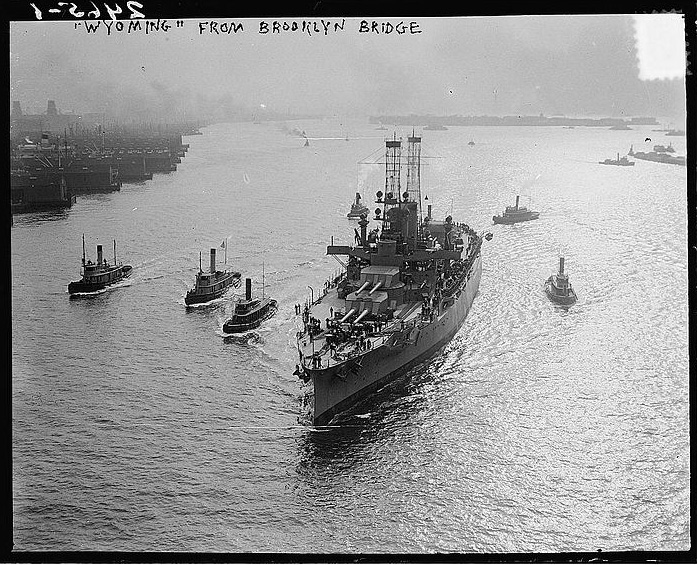
USS Wyoming in the east river, 1912
Development and design of the Wyoming class
Authorized in early 1909 and built between 1910 and 1912, the Wyoming class were the last 12-in gun armed battleships of the US Navy, with a twist: They were also better armed than the former Florida class, having six instead of five turrets. At the same time, the British were built the first next step, the Orion class featuring five turrets with 13.5 inches (340 mm) main guns. The expedient was to use rebored 12-in guns, but it worked and gave an instant advantage to the British three years prior to the war.
However it was not meant to be so. Indeed, the actual president which ordered them was Theodore Roosevelt, and he planned a serie of 355 mm guns-armed battleships instead back in 1908, whereas the Dreadnought concept was not even two years old. On 22 July 1908, the Newport Conference was held with the General Board, Naval War College and headed by President Theodore Roosevelt to decide over the next design:
-Design 601: A ship armed with twelve 12-in (’12-12′) guns
-Design 404: Eight 14-in guns (probably 2×2)
-Design 502: Ten 14-in guns (5×2).
The Ordnance wants compromises
However at the time, the Bureau of Ordnance estimated infrastructures were just not yet fit to handle larger calibers and the development of a 14-in gun would take two years. Another argument was the armor-piercing 12-in calibers were still efficient at 8,000 to 8,500 yd (7,300 to 7,800 m) against the current armour thickness in service. In the ends, the views of the Bureau of Ordnance were adopted, against the President’s wish, notably to avoid delays. Despite of this, the new displacement and size only made two spots for repairs and maintenance available worlwide, in Pearl Harbor and Puget Sound.
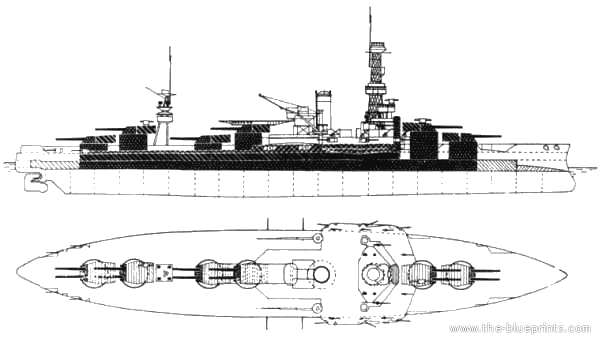
Armour scheme of the Wyoming class
Wet secondary battery and stability issue
Provisionally, it was decided to go for the ‘601’ design, a new arrangement of 12-in guns. As a result, both units were given one extra turret. For the first time also the designers tried a “flush deck” concept, able to deal with the North Atlantic heavy weather in winter. Also evoked in discussions indeed, the wet casemates on the main deck, as shown by the cruise of the great white fleet. However replacing them in the superstructure would have cause concerns of stability as for the excessive top weight. The 5-in guns the navy used were quite heavy indeed. So the casemates were kept but the designers chose a flush-deck hull which made a rise of 4 ft (1.2 m) of the casemates without compromising too much stability.
Innovations in armour
On the armour side, improvements were also on the menu: The belt and barbette armor was increased by an inch (2.5 cm). The funnels base were also reinforced, as shown by damage reports of the Russians at the Battle of Tsushima. They highlighted the high risk of a destroyed exhaust system. The need for improved underwater protection was also put on the table, and for the first time, the Wyoming class incorporated a torpedo bulkhead.
Armament
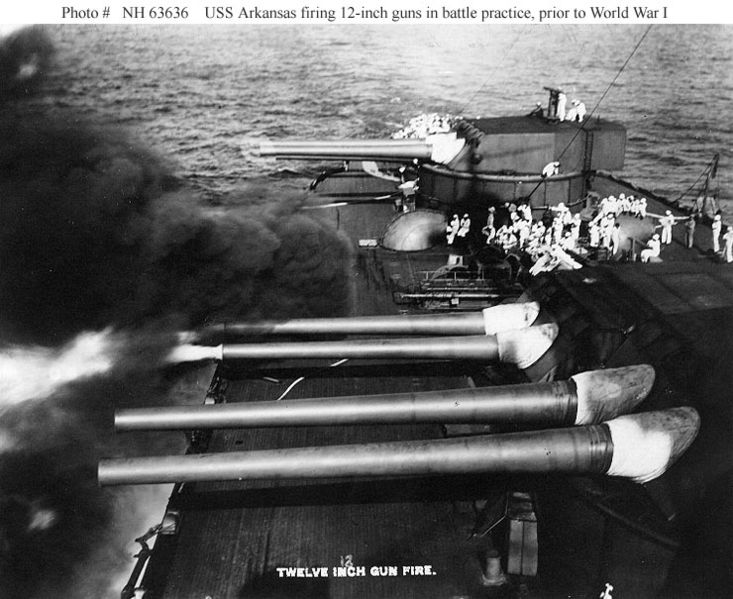
Main battery of USS Arkansas firing
Main battery
Twelve 12-inch/50 caliber Mark 7 Mod 0 guns was the real noverlty of this class. They were placed in six Mark 9 twin-gun turrets, as always, in the centerline. Two were placed in a superfiring pair forward while the other four were also un superfiring pairs aft of the superstructure, intertwined with the rear mast and superstructure. They fired a 870 lb (395 kg) shell with a 353 lb (160 kg) propellant charge. Muzzle velocity was 2,900 ft/s (880 m/s). This model was the last 12-in in service and USS Wyoming and Arkansas were the last and only ships using this ordnance. Previous 12-in guns were in standard the lower-velocity 12-inch/45-caliber Mark 5 gun.
The Mark 7 heavy gun had increased armor penetration figures due to the better muzzle velocity, notably at 12,000 yd (11,000 m), it could pierce through 12.3 in (310 mm) of face-hardened armor. The previous models figure was 10.8 in (270 mm). They were mounted in the Mark IX gun turret complete with their cradle mounts which allowed a 15 degrees elevation and −5 degrees depression. These new turrets had also a previous advantage compared to previous models, they did not required the guns to return to 0 degrees to reload.
Secondary battery
It consisted of twenty-one 5-inch/51 caliber guns (127 mm) in single mounts, in casemates along the hull. As it was said above, the new flush deck design allowed the guns to be higher up and therefore not wet. These guns fired a 50 lb (23 kg) shell at a muzzle velocity of 3,150 ft/s (960 m/s). Part of the telemeters were installed on the two lattice masts.
Tertiary armament
The Wyoming class BBs did not possessed any light gun, either anti-torpedo or AA (aviation was not taken seriously at that time anyway). Like other battleship however they carried a pair of submerged 21-inch (530 mm) torpedo tubes in the hull, broadside. This was linked to a large belief that firing torpedo in a battleline, against another battleline could result in random kills. The tactic was used at Tsushima without success, and at Jutland again with the same result. Distance was too great and the concept as later dropped. These torpedoes used the Mark III Bliss-Leavitt design, carrying a 218 lb (99 kg) warhead, and its range was 4,000 yd (3,700 m). They could reach 26.5 kn (49.1 km/h; 30.5 mph).
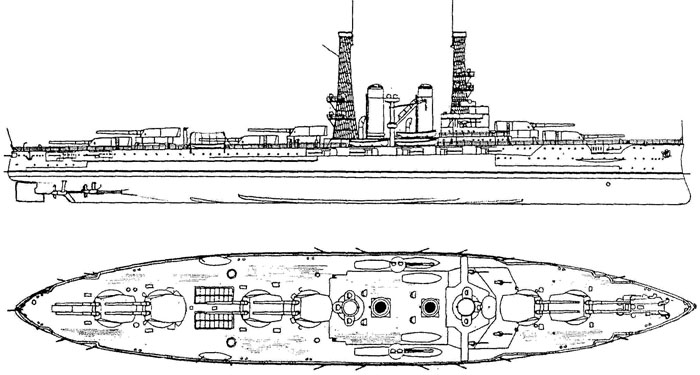
Top and side view of the Wyoming class, as built (the blueprints)
Protection
The main belt was 8 ft (2.4 m) high overall, 11 in (280 mm) thick over the citadel, protecting the ammunition magazines and boilers rooms. It was reduced to 5 in (130 mm) near the stern and on the bottom edge down to 9 in (230 mm). The forward end met an 11 in thick transverse bulkhead. It was in front of the main battery barbette, while the rear of the citadel was protected by a 9 in bulkhead. The main armored deck was 2.5 in (64 mm) thick. This was a special treatment steel, down to 1.5 in (38 mm) in less important spaces. The conning tower had 11.5 in (292 mm) thick walls, and its roof was 3 in (76 mm) in thickness.
The gun turrets were protected by the same equivalent of caliber, 12 in (305 mm) on their face faces, sides, down to 3 inches thick roofs (76 mm). The barbettes rings were 11 inches thick on the exposed part above the citadel. Below the armoured deck it was down to 4.5 in (110 mm). The lower half of the casemate was 11 in thick (280 mm), upper half 6.5 in (170 mm). It was enclosed by longitudinal bulkheads also protecting the funnels uptakes as learnt during the Russo-Japanese War. Smoke proved a liability in this battle, and draft collapsed (so speed) after the funnel bases were hit. The other innovation, certainly more important, was for the first time the adoption of a comprehensive ASW compartmentation and torpedo bulkhead. The brand new feature was repeated on all subsequent USN Battleships designs.
Propulsion
Te Wyoming class were propelled by four shaft Parsons steam turbines, rated for a total of 28,000 shp (21,000 kW). They were fed by twelve mixed oil/coal-fired Babcock & Wilcox boilers. They were truncated into two spaced funnels. Top speed as designed was 20.5 knots (38.0 km/h; 23.6 mph). But on trials, USS Arkansas reached 21.22 knots (39.30 km/h; 24.42 mph) with a total output of 25,546 shp (19,050 kW). Both battleships carried 1,667 long tons (1,694 t) of coal, 266 long tons (270 t) of oil, enough to reach 6,700 nautical miles (12,400 km; 7,700 mi) at 10 knots (19 km/h; 12 mph), down to 2,655 nmi (4,917 km) at 20 knots. The ships were moderately agile, with a single rudder for steering. The flush-deck option proved its worth in service as their secondary battery was less wet.
Construction
Congress approved two new battleships, BB-32 and BB-33, on 3 March 1909. Design 502 was also used, with few modifications on the next New York class.
USS Wyoming (BB-32) was started at William Cramp & Sons NyD on 9 February 1910 and launched on 25 May 1911. She was completed on 25 September 1912. Her sister ship USS Arkansas (BB-33) was laid down at New York Shipbuilding Corporation on 25 January 1910, so before the Wyoming, and launched on 14 January 1911, so way earlier, to be completed on 17 September 1912. This is why the class is often referred to Arkansas class as well. Both were among the most powerful battleships afloat at that date, with an unmatched axial battery which favour broadsides. The design was repeated on the New York and influenced the Argentine Rivadvia class greatly.
For more, see the detailed plans of the Wyoming there.
Interwar modifications
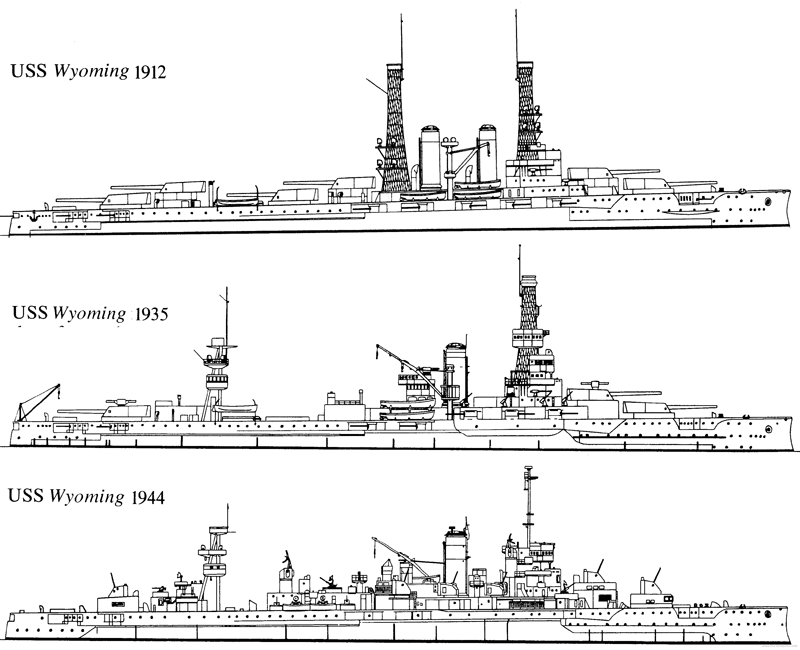
Evolution of USS Wyoming, various modernizations as a battleship in 1912, training ship in 1937 and AA training ship ACG-17 in 1944 (bottom)
Both battleships already received modifications during and shortly after the great war: The horizontal armor was improved, the roof of the conning tower was thickened as well as those of the main gun turrets. Deck armor was increased to 3.5 in (89 mm). Armament-wise, eight 3-inch (76 mm)/50 caliber AA guns were installed, the only light artillery on board.
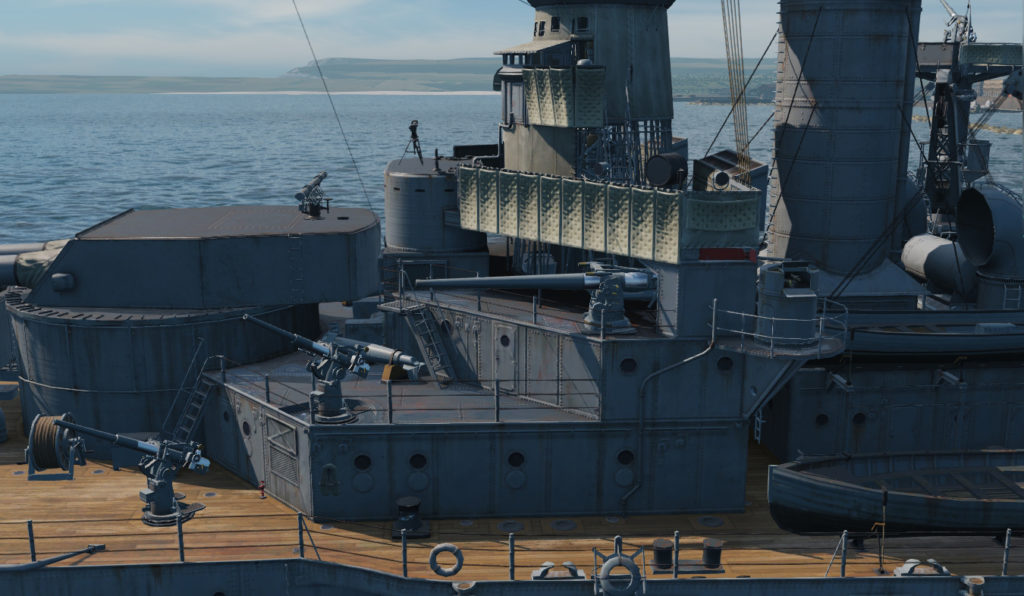
Details of the bridge and forward section (wow)
After the Washington Naval Treaty of 1922, modernization process fell under tight treaty controls, and that included restrictions on armor and armament. Displacement could be increased to 3,000 long tons (3,000 t), a provision for whatever needed, but the main battery guns and their mounts were forbidden of any improvements. Protection wise, main areas it concentrated on aerial and underwater threats, and the propulsion systems could be upgraded as well.
This work was undergone in the 1920s, first off in drydock, they received oil-fired boilers from the cancelled South Dakota-class battleships. Exhausts were truncated into a single funnel. These new boilers allowed an increase in cruising radius, 11,000 nmi (20,000 km; 13,000 mi). Both featured anti-torpedo bulges, to improve their underwater protection. These additional spaces were also used for additional oil storage capacity. Their fore cage mast was also deposed and replaced by a short tripod, on top fo which were placed searchlights and radio antennas. The secondary battery was also partly relocated on the deck to improve the ship’s seaworthiness. The eight 3-inch AA guns were relocated to the top sponson top. Of course, the torpedo tubes were removed.
In 1930 the London Naval Treaty imposed new limitations and USS Wyoming was demilitarized, converted into a training ship. Due to this process, anti-torpedo bulges were removed, as well as the side armor half of the main battery, a process which took place at Norfolk Navy Yard 12 January-3 April 1944. The refit saw the last of her three 12-in gun turrets removed, replaced by four twin and two single enclosed mounts, supporting 5-inch/38 guns. A brand new fire control radar was installed and these modifications allowed the ship to train AA gunners. USS Arkansas was modified up to 1942, with a new tripod foremast, modified bridgework and AA guns, with new quadruple 40 mm Bofors mounts (nine quad), twenty-eight 20 mm Oerlikon and ten 3-inch guns in 1945.
USS Wyoming in service
USS Wyoming prewar service
Soon after commission, USS Wyoming join the fleet at Hampton Roads in December 1912, as flagship of Rear Admiral Charles J. Badger, Atantic fleet commander. She served in the Caribbean, visited the Panama Canal nearing completion, and made exercises off Cuba. She was back in Chesapeake Bay in March and to the East River.
On 18 April, she entered the drydock of York Navy Yard for repairs, until 7 May and participated in maneuvers off Block Island but her machinery proved troublesome, and she was again repaired at Newport later in May. She joined Annapolis to trainnaval cadets taking them in a summer midshipman cruise. She also took part in gunnery and torpedo training, returned to New York for further repairs, which lasted until 2 October. She underwent full–power sea trials to test these new machinery and sailed to the Virginia Capes for fleet maneuvers.
She later sailed to Europe in a goodwill cruise from 26 October via the Mediterranean Sea, visiting Valletta, Malta, Naples, Italy, Villefranche and sailed back to NY on 30 November. In January 1914 she was out in commission again, out of drydock maintenance. She participated in the annual fleet maneuvers in the Caribbean until 15 March, stopping at Guantanamo Bay Naval Base, Tangier Sound, and after an overhaul in New York until 9 May 1914, she went back to Hampton Roads, carryong troops to Veracruz (18 May) during the Mexican Revolution. She returned to Virginia Capes and in October joined New York for maintenance.
Wyoming’s Operations in WW1
After joining Hampton Roads, exercizes off Cuba, Block Island, she was back to New York for an overhaul and in January 1916, proceeded to the Caribbean, visiting Culebra, Puerto Rico, Port-au-Prince, and Guantanamo for more fleet maneuvers. After her usual New York maintenance, she was back in June for fleet maneuvers off the Virginia Capes and by January 1917, she was in Cuban waters and was off Yorktown, Virginia when the US declared war on Germany (6 April). After some preparations and training of extra personal which lasted until September, from 25 November she joined Battleship Division 9 (BatDiv 9), together with USS New York, Delaware, and Florida, and joined the firth of forth, Grand Fleet at Scapa Flow. There, she was soon part of the new integrated 6th Battle Squadron of the Grand Fleet, making exra training in these waters.
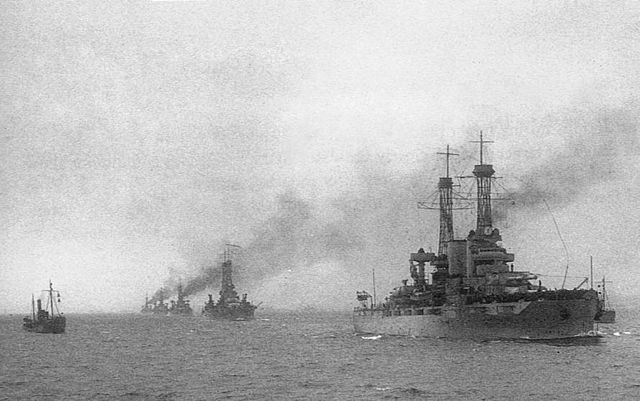
USS Wyoming with BatDiv 9 at Scapa Flow
By 6 February 1918, USS Wyoming made her first wartime operation, escorting a convoy to Stavanger in Norway, covered by eight British destroyers. Lookouts mistook German U-boats attacking the ships with torpedoes and the convoy eventually reached unharmed Norway. She was back to Scapa, withing two more days. She then patrolled the North Sea, preventing any sortie of the German High Seas Fleet. On 30 June the 6th Battle Squadron covered a minelaying operation, until 2 July. Later the squadron joined covered Convoy HZ40 returning from Norway.
On 14 October, USS New York collided an U-boat, damaging her screws, therefore admiral Rodman transferred his flag to Wyoming for the remainder of the operations. On 21 November, the Armistice saw the USN battleships escorting the High Seas Fleet in the North Sea, to Scapa Flow. On 12 December USS Wyoming was flagship of Rear Admiral William Sims which replaced Rodman at the head of BatDiv 9, and the squadron left UK for France, Brest, with USS George Washington carrying President Woodrow Wilson to the peace negotiations. She was back to Britain and departed for the US, New York for an overhaul and was back in service with BatDiv 7 as a flagship in January 1919, flying Rear Admiral Robert Coontz colors.
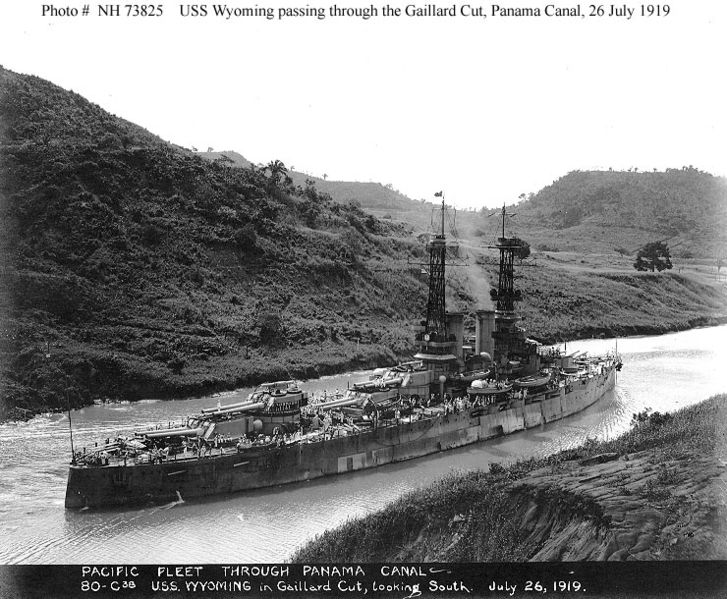
USS Wyoming through the Panama canal in 1919
Interwar modifications
In 1919, USS Wyoming took part in the annual fleet maneuvers off Cuba, alternated with overhauls in New York. In 12 May she guided a group of Navy Curtiss NC flying boats for their first aerial transatlantic crossing. She also trained midshipmen off the Chesapeake Bay and Virginia Capes. She was drydocked at Norfolk Navy Yard on 1 July for afirst modernization, this tile to serve in the Pacific. The secondary battery was reduced among others, and she was re-commissioned as flagship, BatDiv 6 Pacific Fleet. In July she passed the Panama Canal and sailed to San Diego, California by August. She then sailed to San Pedro and Puget Sound for an overhaul lasting until April 1920.
She left San Pedro for Hawaii, for more training exercises and later maneuvers back on the west coast. She left San Francisco on 5 January 1921 for a long cruiser in South American waters, stopping at Valparaíso, Chile for a state visit and back to Puget Sound on 18 March. In August she was in Balboa, Panama Canal Zone, with Rear Admiral Rodman. She went back through New York to the Atlantic Fleet, as flagship of Admiral Hilary P. Jones. The next three this was the usual routine of winter fleet exercises off Cuba and summer maneuvers off the east coast. She was nect the flagship of Vice Admirals John McDonald, Newton McCully, and Josiah McKean, Scouting Fleet. In the summer of 1924, she trained midshipman in an European cruise, stopping in Torbay (UK), Rotterdam, Gibraltar, and the Azores. She also took part in February 1924 to Fleet Problem II, III, and IV, in the “Blue” force.
By February 1925, she went through the Panama Canal agaon to serve with the Pacific Fleet. She made exercizes off California and Hawaii, stopped at San Diego and was back to the east coast, making a later cruise to Cuba and Haiti. Her NY overhaul lasted until 26 January 1926 and she received a new Commander, William F. Halsey, Jr., ready to serve on 4 January 1927. In August, she sailed to Philadelphia for extensive modernizations in drydocks. All boilers were replaced, anti-torpedo bulges added, and work resumed by 2 November. She made a trials cruiser off Cuba and the Virgin Islands and was back in Philadelphia by December 1927, becoming flagship of the Scouting Fleet (Vice Admiral Ashley Robertson).
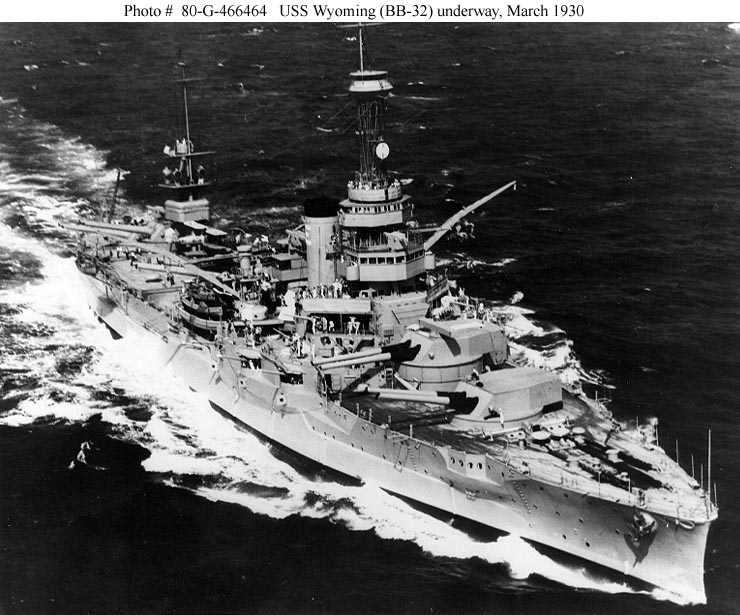
USS Wyoming in March 1930
The next three years were spent in this new Scouting Fleet service, training Naval Reserve Officer Training Corps (NROTC) cadets throughout the Atlantic, Gulf of Mexico, Azores, Nova Scotia. In November 1928, she picked up survivors from the wrecked steamship SS Vestris and on 19 September 1930, she joined BatDiv 2 as flagship of Rear Admiral Wat T. Cluverius. On 4 November she was withdrawn from front-line service at last. She became the flagship of the Training Squadron (Rear Admiral Harley H. Christy).
At Philadelphia on 1 January 1931 she was placed on reduced commission under the London Naval Treaty limitations. She was to be demilitarized, with her anti-torpedo bulges, side armor, half of her main battery guns removed. In May 1931 she was back into service, training midshipmen from Annapolis to Europe, rescuing en route the disabled submarine O-12 and stopping in Copenhagen, Denmark, Greenock, Scotland, Cadiz, Spain, and Gibraltar. Back in Hampton Roads (13 August) she was reclassified as “AG-17”. While training NROTC cadets one of her 5-in turret blasted on 18 February 1937 during exercises, when a 5-inch shrapnel shell exploded, killing 6, while 11 were wounded. In 1938 she was temporary flagship for Rear Admiral Wilson Brown (Training Squadron Cdr).
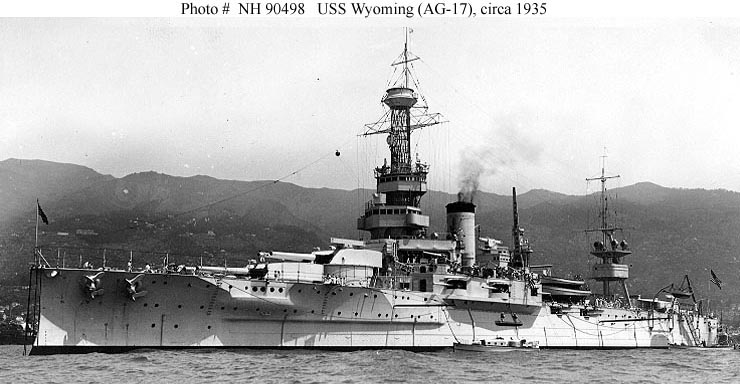
USS Wyoming in 1935 after modernization as training battleship
The USS Wyoming during WW2
When the war broke out, USS Wyoming was assigned to the Atlantic naval reserve force alongside New York, Arkansas, Texas and the carrier USS Ranger and she became the flagship of Rear Admiral Randall Jacobs (Patrol Force, 2 January 1941). By November, she became a full-time gunnery training ship and was off Platt’s Bank when the attack at Pearl Harbor took place. She went to serve as a gunnery training ship from February 1942, mainly in the Chesapeake Bay area and her role cannot be underestimated: The “Chesapeake raider” trained thousands of young anti-aircraft gunners on all the AA arsenal in servce with the USN, from the .50 cal. “Ma Deuce” to the dual 5-in gun. At some point the admiralty contemplated her conversion back to a full battleship configuration, but costs were prohibitive.
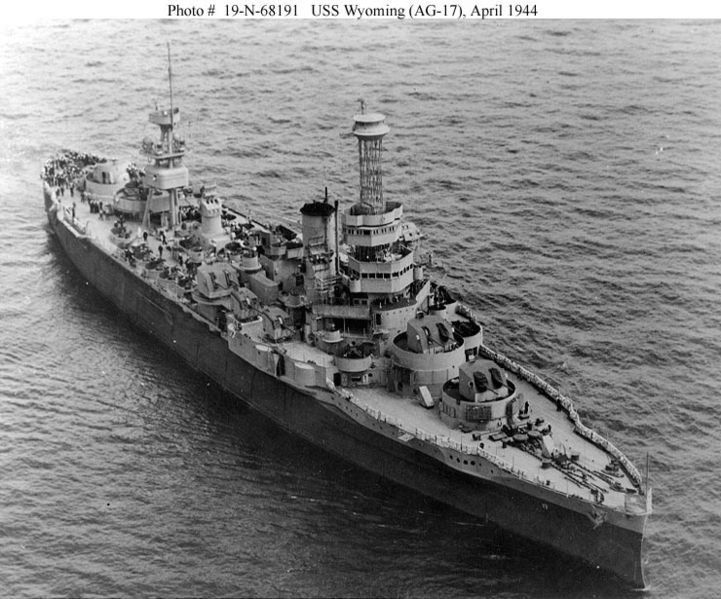
USS Wyoming in 1944
Wyoming was modernized at Norfolk Navy Yard, 12 January-3 April 1944, loosing her last 12-in turrets, while four twin and two single 5-inch/38 gun mounts were installed instead along with brand new fire control radars, back in service by 10 April. She would trainin total on average 35,000 AA gunners on the 5-in, 3-in, 1.1-in, 40 mm, 20 mm Oerlikon, and smaller .50 cal/.30 cal, firing more ammunition than any other USN ship in the fleet !
Her training duties in the Chesapeake ended on 30 June 1945. She went to New York Navy Yard for her last modifications and she joined Casco Bay, Composite Task Force 69 (CTF 69) (Vice Admiral Willis A. Lee.) to answer Japanese kamikaze tactics, with many experimental gunnery drills in which towed sleeves, drone aircraft, and radio-controlled targets were used. CTF 69 became the “Operational Development Force”, and she served in this guuse until September 1945, testing new fire control equipment. On board was also the ensign Jimmy Carter, future President. On 11 July 1947, she was decommissioned in Norfolk while Mississippi as AG-128 took over her previous gunnery role. She was stricken from Registry on 16 September, sold for scrap on 30 October and dismantled by Lipsett, Inc. New York.
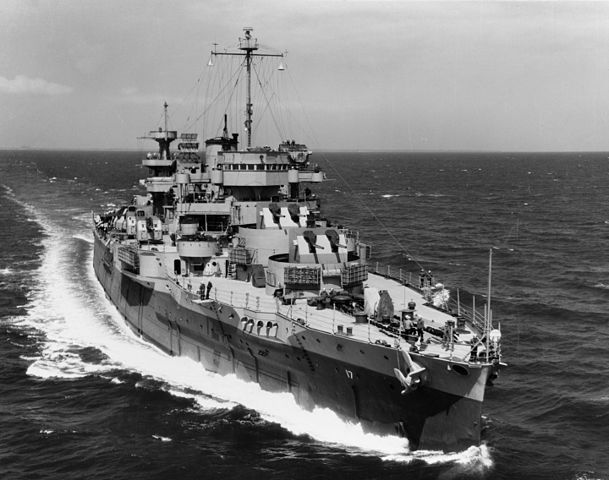
USS Wyoming on 30 April 1945 as AG-17, Chesapeake bay, after her last modernization.
USS Arkansas
The Arkansas in 1912-18
Prior to WW1, USS Arkansas underwent a routine of training cruises, and New York Navy Yard for periodic maintenance. She participated soon after commission in a fleet review on 14 October 1912 for President William Howard Taft. She carried the president to the Panama Canal zone. She started from Key West, Florida to NY and the Atlantic fleet, making later a tour of the Mediterranean Sea from late October 1913. In 1914 she also participated in the American occupation of Veracruz. Two of Arkansas’s crewmen were killed in the fighting and two others received the Medal of Honor. She also served from Newport, Rhode Island, making torpedo practice and tactical maneuvers in Narragansett Bay. She served routinely in the Carribean waters.
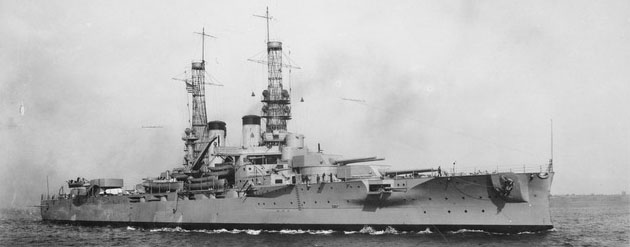
USS Arkansas circa 1918
In 1917, when US declared war on Germany, USS Arkansas was at Battleship Division 7 stationed in Virginia. She patrolled the east coast and trained her crews for several months. She sailed to UK in July 1918, relieving the battleship USS Delaware of BatDiv 9, Grand Fleet 6th Battle Squadron. Apperently during a patrol she mistook an U-Boat persicopes and soon dropped depth charges but did not hit the alleged target, which was never identified. She also secorted the German Hochseeflotte to Scapa Flow after Germany surrendered, and escorted later the ocean liner SS George Washington carrying President Wilson to France. She was back to NY on 26 December, participating in a Naval Review for Secretary of the Navy Josephus Daniels.
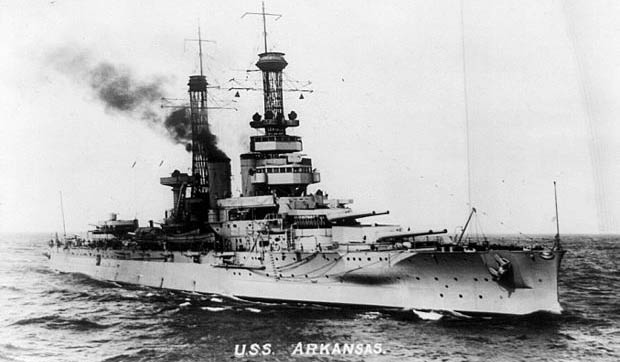
USS Arkansas in 1920
The interwar
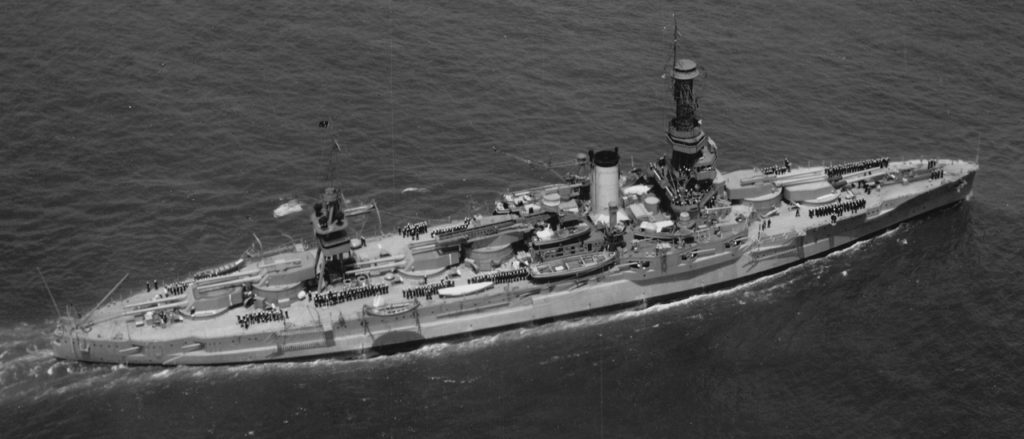
Top view of the USS Arkansas in 1927, during a naval review
The ship was yearly busy between individual training, annual fleet maneuvers and periodic maintenance in NY, but also engineering and gunnery competitions. She also served as a reference vessel to guide Navy Curtiss NC flying boats over the Atlantic for their first crossing. In 1920-21 she served in the Pacific, via the Panama Canal and based at San Francisco, carrying Secretary and Mrs. Josephus Daniels and later participated in a naval review for President Wilson. She was back in August 1921 as flagship of the Atlantic Fleet. She made a tour of Europe in 1923, visiting Copenhagen, Lisbon and Gibraltar and did the same in 1924. In 1925 she served on the east coast and California. Later that year she was overhauled in Philadelphia Navy Yard, receiving new boilers.
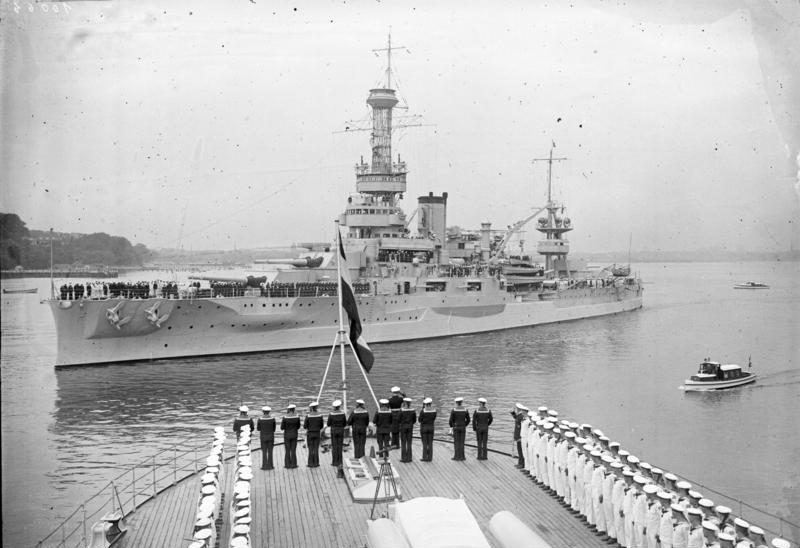
In 1928 after a cruise with midshipmen she participated in a fleet exercize as part of the hostile “attacking” fleet. In 1929 USS Arkansas cruised in the Caribbean and Canal Zone and after maintenance at NYC, cruiser in Europe, stopping at Cherbourg, Kiel, Oslo, and Edinburgh. In 1931 she did the same, stopping at Copenhagen, Greenock, Cadiz and Gibraltar. She also participated in Fleet Problem XII in which she was “sank” by a dummy torpedo as flagship under Admiral Arthur L. Willard. After the Yorktown Sesquicentennial celebrations in October 1931 she carried President Hoover to the exposition, and to Annapolis at the end of the year. In 1932 she was refitted and recommissioned under George Landenberger, joining the Pacific Fleet.
She made another tour of Europe in 1934, stopping at Plymouth, Nice, Naples, and Gibraltar. She carried the 1st Battalion, 5th Marines to Culebra, for Fleet Landing Exercise No. 1 (FLEX 1), January 1935 and FLEX 2 in January 1936, before another tour of Europe in 1936, visiting Portsmouth, Gothenburg, and Cherbourg. She made another 1937 European tour, carrying midshipmen and the next year until 1939 stayed in the Western Atlantic.
Wartime service
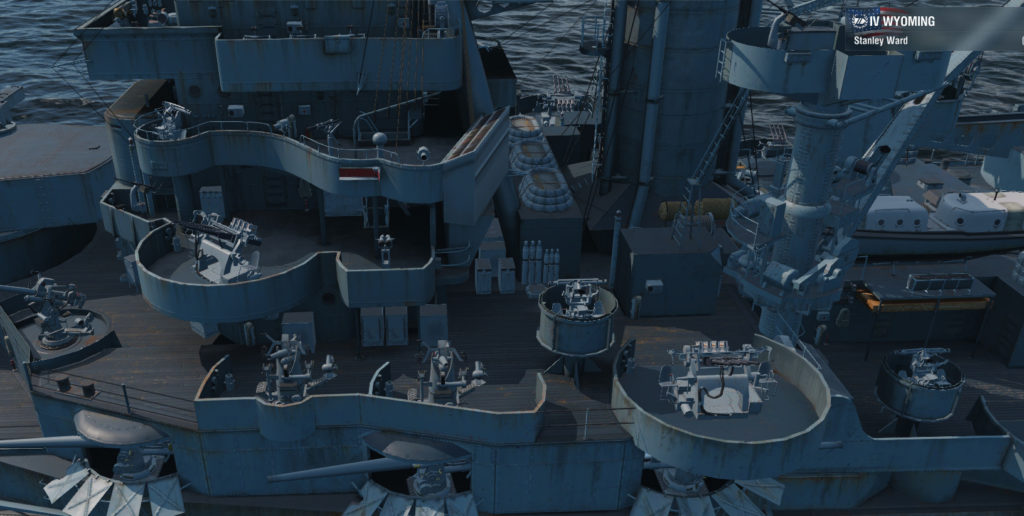
wow’s Arkansas, details of the bridge
USS Arkansas was based at Hampton Roads when the war broke out. She went to the Naval Reserve and carried men, equipments to the future naval air base of Narragansett. She joined her sister ship to the reserve force for the Neutrality Patrols in the Atlantic. She completed a tour of maneuvers off Cuba and went to an overhaul at Norfolk (18 March-24 May 1940). On 19 December 1940 however, with 500 naval reservists on board, USS Arkansas collided with the outbound Collier Melrose during night hours, and the latter sank. But her survivors were picked up. Her only damages were some paint scratched and a smashed lifeboat.
Her active wartime career took an interesting twist when she particopated in the occupation of Iceland, in July 1941, together with USS New York, two cruisers and eleven destroyers, deployed from NS Argentia, Newfoundland. She resumed her duties in neutrality patrol in the mid-Atlantic, but was in Casco Bay, Maine, on 7 December 1941. She sailed to Hvalfjordur, Iceland, and returned to Boston on 24 January 1942, for later more training and patrols. On 6 March, she entered drydock at Norfolk, for an overhaul. Her light AA armament and 3-inch/50 armament were increased. She became the flagship of Task Force 38 (TF 38), escorting convoys to Greenock.
By the fall of 1942 she was ecorting convoys this time to North Africa, to support the invasion of North Africa. She was back in NYC for another overhaul and returned to the Mediterranean from January 1943 to assist US Forces after Operation Torch, bound to, and back from Casablanca. On 8 October, she steamed to Bangor, Northern Ireland and made other escorts until 1944. By April of that year she trained for shore bombardment duties, in preparation for operation Overlord. On the morning of 6 June, she take a position about 4,000 yd (3,700 m) from Omaha Beach ans commenced firing (for the first time in anger) at 05:52 on German bunkers and positions. On 13 June she supported operations of ground forces in Grandcamp les Bains. On 25 June she bombarded Cherbourg, helping troops to advance in the German-occupied port.
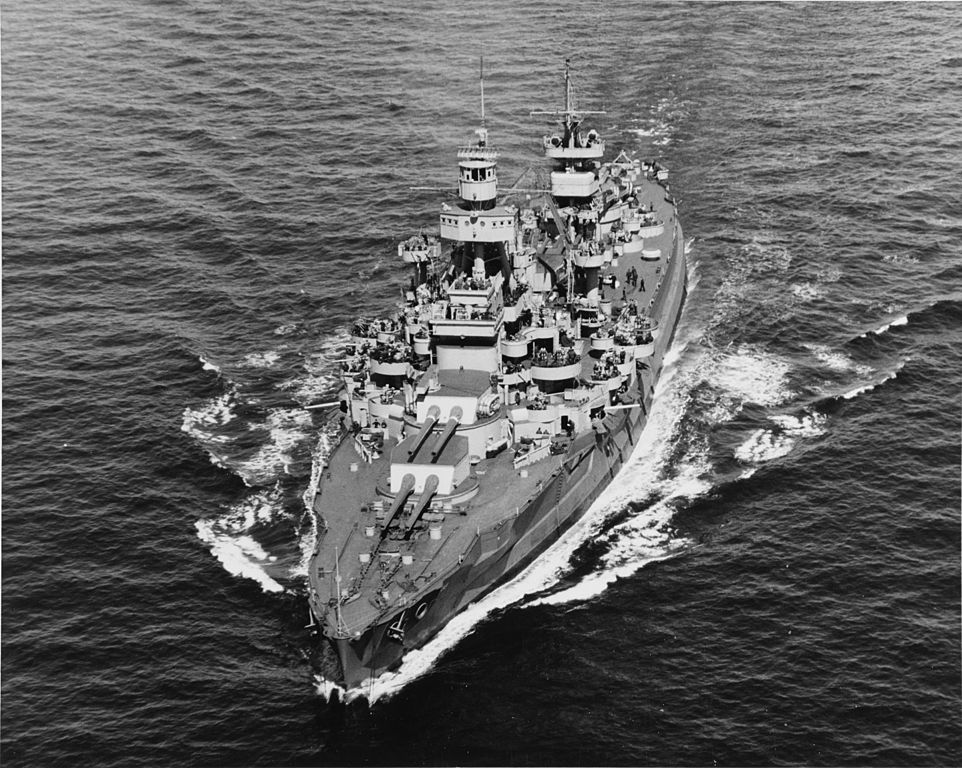
Arkansas in 1944
She will ater depart to Weymouth, and then to Bangor, Ireland, then she sailed for the Mediterranean Sea, reached Oran inAlgeria, and Tarento, in July 1944 in preparation for Operation Anvil Dragoon, the landings in Provence. She covered the landings for two days with six Allied cruisers, starting on 15 August. She withdrew to Palermo, Oran and departed for Boston for another refit which lasted until November 1944.
She went through thePanama canal to California, spending the rest of 1945 in training maneuvers before departing on 20 January 1945 for Pearl Harbor, and the Ulithi Attoll in preparation for the amphibious assault on Iwo Jima, with TF 54. On 16 February, 06:00, USS Arkansas opened fre on Japanese positions. Her shelling lasted until 19 February, but she stayed there in order to provied on demand fire support to US Marines until 7 March. She departed to be rearmed and refueled in order to be ready to participate in the last great amphibious assault of the war, the invasion of Okinawa. She was in place by 21 March, providing gunfire support over the course of 46 days. During these days she was repeatedly attacked by Kamikaze squadrons. Her consistent AA provision repelled them all, and despite some near-hits, none struck her. She was back in Guam by 14 May.
She was in Leyte gulf in June 1945, together with Task Group 95.7, along with USS Texas and three cruisers. She remained there until 20 August, and until the Japanese surrendered. In all she would earn four battle stars for her wartime service. Her end was however less glamorous -albeit useful-. After participating in Operation Magic Carpet, the repatriation of American servicemen from the Pacific, she went to San Francisco and Hawaii, Pearl Harbor (8 May 1946) and sailed on 20 May, for the Bikini Atoll, in preparation for Operation crossroads. Ths nuclear experiment started on 1 July (Test ABLE), hit by the air burst. 24 days later at test BAKER however she was sunk by the blast, hit wave and seawave. The shock was apparently “transmitted directly to underwater hulls”, and she capsized, broken only at 230 m (250 yd) from the epicenter. The photo is telling enough. Her she layed up to this day, bottom up, under 180 ft (55 m) of water, an irradiated hulk.
Specifications in 1914 |
|
| Dimensions | 171.30 x 28.40 x 8.7 m – 93 ft 3in, 28 ft 6 in, 29 ft 7 in |
| Displacement | 26,000 long tons Standard, 27,240 tonnes Fully Loaded |
| Crew | 1063 total |
| Propulsion | 4 shafts Parsons turbines, 12 mixed Babcock et Wilcox, 28,000 ihp |
| Speed | 20.5 knots (), Range: xxxxx nm |
| Armament | 12 × 12in (305), 21 × 5in (127), 2x 21in (533 mm) TTs sub bd |
| Armor | Belt, casemate, barbettes 11in (280 mm), turrets 12 in, CT 11.5 in |
Specifications (Arkansas) in WW2 |
|
| Dimensions | Same but width 30 m (100 feets) |
| Displacement | 26,066 long tons Standard, 31,000 tons FL |
| Crew | 1650 |
| Propulsion | 4 shafts Parsons turbines, 4 oil-fired Babcock et Wilcox boilers 28,000 ihp |
| Speed | 20.5 knots (), Range: 11,000 nmi (20,000 km; 13,000 mi) |
| Armament | 12 × 12 in, 6 × 5 in, 10 × 3 in, 36 × 40 mm, 26 × 20 mm AA |
| Armor | Same but Decks 51-76 mm, Conning tower 12 in |

USS Wyoming in 1917
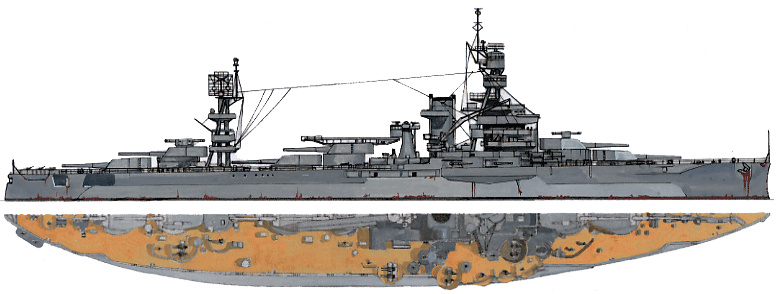
USS Arkansas in 1942 – Both, author’s illustrations
Sources/Read More
Dictionary of American Naval Fighting Ships.
Friedman, Norman (1985). U.S. Battleships: An Illustrated Design History.
Breyer, Siegfried (1973). Battleships and Battle Cruisers 1905–1970. Doubleday and Company
Hore, Peter (2006). Battleships of World War I. London: Southwater Books
US Navy, Naval History and Heritage Command (11 May 2009). “USN Ship Types-Battleships
Friedman, Norman (2011). Naval Weapons of World War One. Seaforth Publishing
http://shipbucket.com/forums/viewtopic.php?f=12&t=8675
naval-encyclopedia.com/ww1/pages/us_navy/us_navy14_18.htm
https://en.wikipedia.org/wiki/Florida-class_battleship
Conway’s all the world fighting ships 1860-1905 and 1906-1921.
Models corner:
To complete.

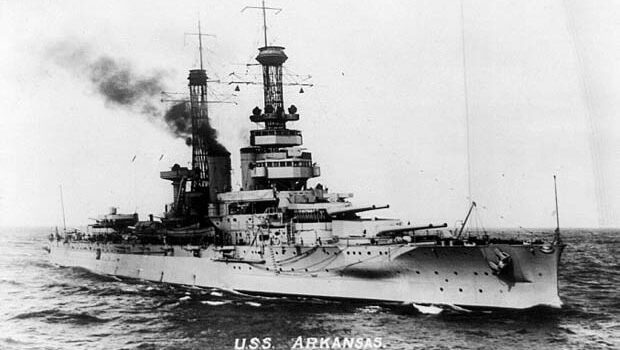
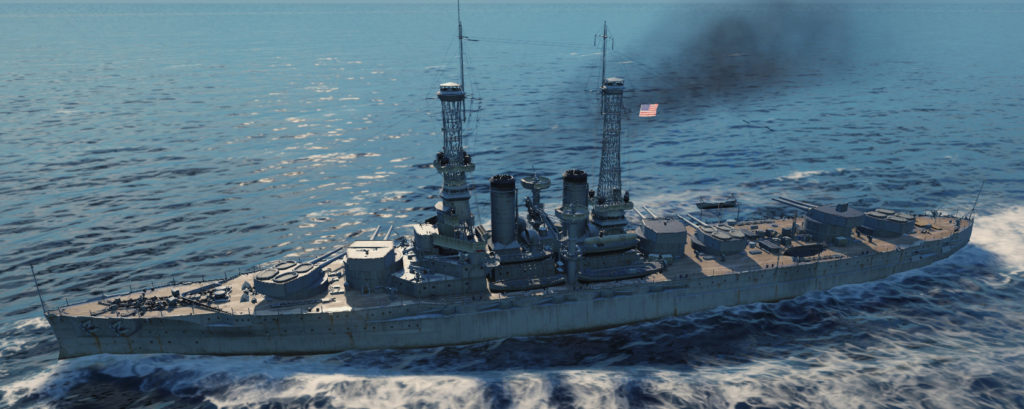
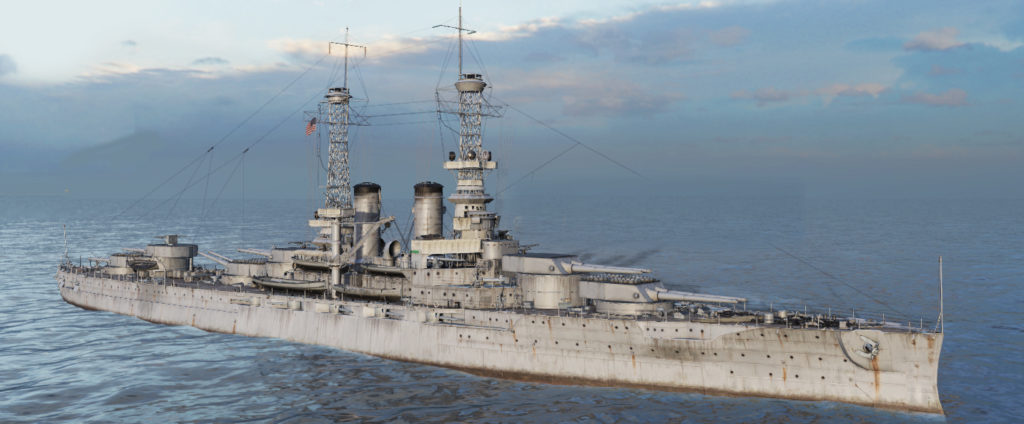

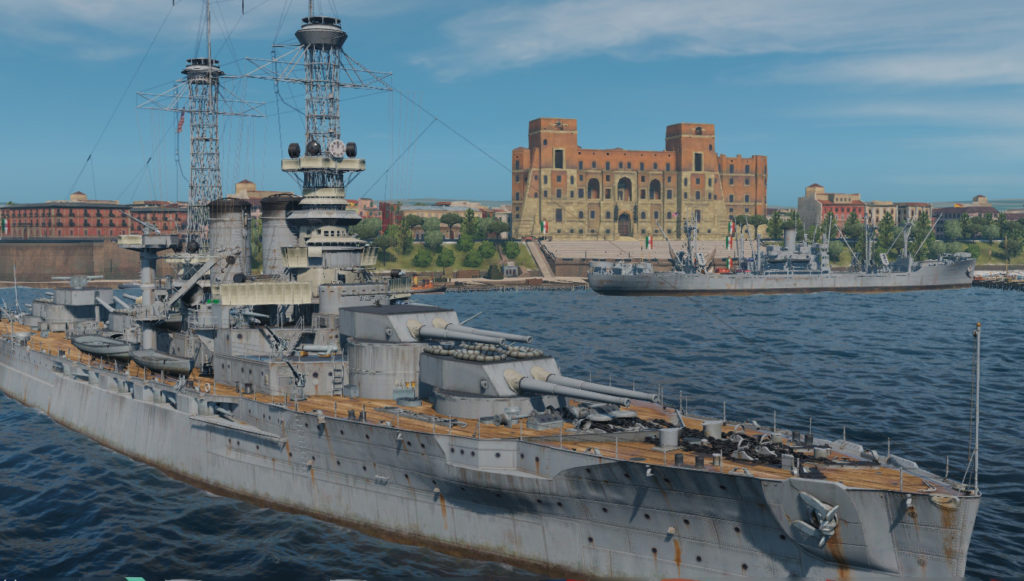
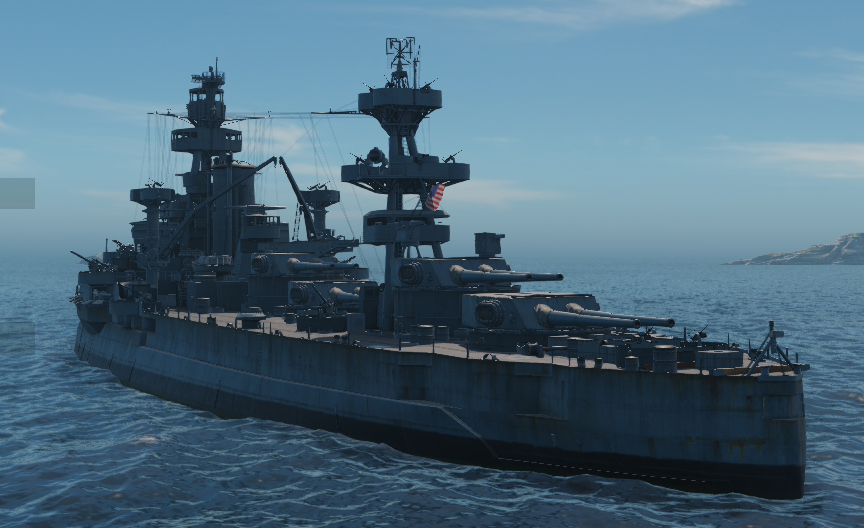
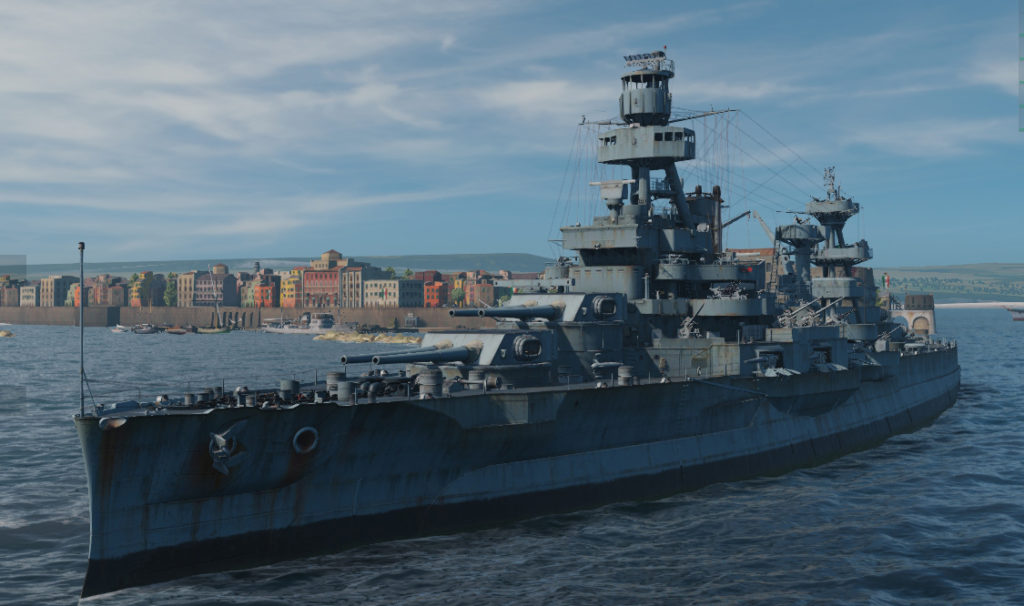

 Latest Facebook Entry -
Latest Facebook Entry -  X(Tweeter) Naval Encyclopedia's deck archive
X(Tweeter) Naval Encyclopedia's deck archive Instagram (@navalencyc)
Instagram (@navalencyc)





 French Navy
French Navy Royal Navy
Royal Navy Russian Navy
Russian Navy Armada Espanola
Armada Espanola Austrian Navy
Austrian Navy K.u.K. Kriegsmarine
K.u.K. Kriegsmarine Dansk Marine
Dansk Marine Nautiko Hellenon
Nautiko Hellenon Koninklije Marine 1870
Koninklije Marine 1870 Marinha do Brasil
Marinha do Brasil Osmanlı Donanması
Osmanlı Donanması Marina Do Peru
Marina Do Peru Marinha do Portugal
Marinha do Portugal Regia Marina 1870
Regia Marina 1870 Nihhon Kaigun 1870
Nihhon Kaigun 1870 Preußische Marine 1870
Preußische Marine 1870 Russkiy Flot 1870
Russkiy Flot 1870 Svenska marinen
Svenska marinen Søværnet
Søværnet Union Navy
Union Navy Confederate Navy
Confederate Navy Armada de Argentina
Armada de Argentina Imperial Chinese Navy
Imperial Chinese Navy Marinha do Portugal
Marinha do Portugal Mexico
Mexico Kaiserliche Marine
Kaiserliche Marine 1898 US Navy
1898 US Navy Sovietskiy Flot
Sovietskiy Flot Royal Canadian Navy
Royal Canadian Navy Royal Australian Navy
Royal Australian Navy RNZN Fleet
RNZN Fleet Chinese Navy 1937
Chinese Navy 1937 Kriegsmarine
Kriegsmarine Chilean Navy
Chilean Navy Danish Navy
Danish Navy Finnish Navy
Finnish Navy Hellenic Navy
Hellenic Navy Polish Navy
Polish Navy Romanian Navy
Romanian Navy Turkish Navy
Turkish Navy Royal Yugoslav Navy
Royal Yugoslav Navy Royal Thai Navy
Royal Thai Navy Minor Navies
Minor Navies Albania
Albania Austria
Austria Belgium
Belgium Columbia
Columbia Costa Rica
Costa Rica Cuba
Cuba Czechoslovakia
Czechoslovakia Dominican Republic
Dominican Republic Haiti
Haiti Hungary
Hungary Honduras
Honduras Estonia
Estonia Iceland
Iceland Eire
Eire Equador
Equador Iran
Iran Iraq
Iraq Latvia
Latvia Liberia
Liberia Lithuania
Lithuania Mandchukuo
Mandchukuo Morocco
Morocco Nicaragua
Nicaragua Persia
Persia San Salvador
San Salvador Sarawak
Sarawak Uruguay
Uruguay Venezuela
Venezuela Zanzibar
Zanzibar Warsaw Pact Navies
Warsaw Pact Navies Bulgaria
Bulgaria Hungary
Hungary

 Bundesmarine
Bundesmarine Dutch Navy
Dutch Navy Hellenic Navy
Hellenic Navy Marina Militare
Marina Militare Yugoslav Navy
Yugoslav Navy Chinese Navy
Chinese Navy Indian Navy
Indian Navy Indonesian Navy
Indonesian Navy JMSDF
JMSDF North Korean Navy
North Korean Navy Pakistani Navy
Pakistani Navy Philippines Navy
Philippines Navy ROKN
ROKN Rep. of Singapore Navy
Rep. of Singapore Navy Taiwanese Navy
Taiwanese Navy IDF Navy
IDF Navy Saudi Navy
Saudi Navy Royal New Zealand Navy
Royal New Zealand Navy Egyptian Navy
Egyptian Navy South African Navy
South African Navy






























 Ukrainian Navy
Ukrainian Navy dbodesign
dbodesign